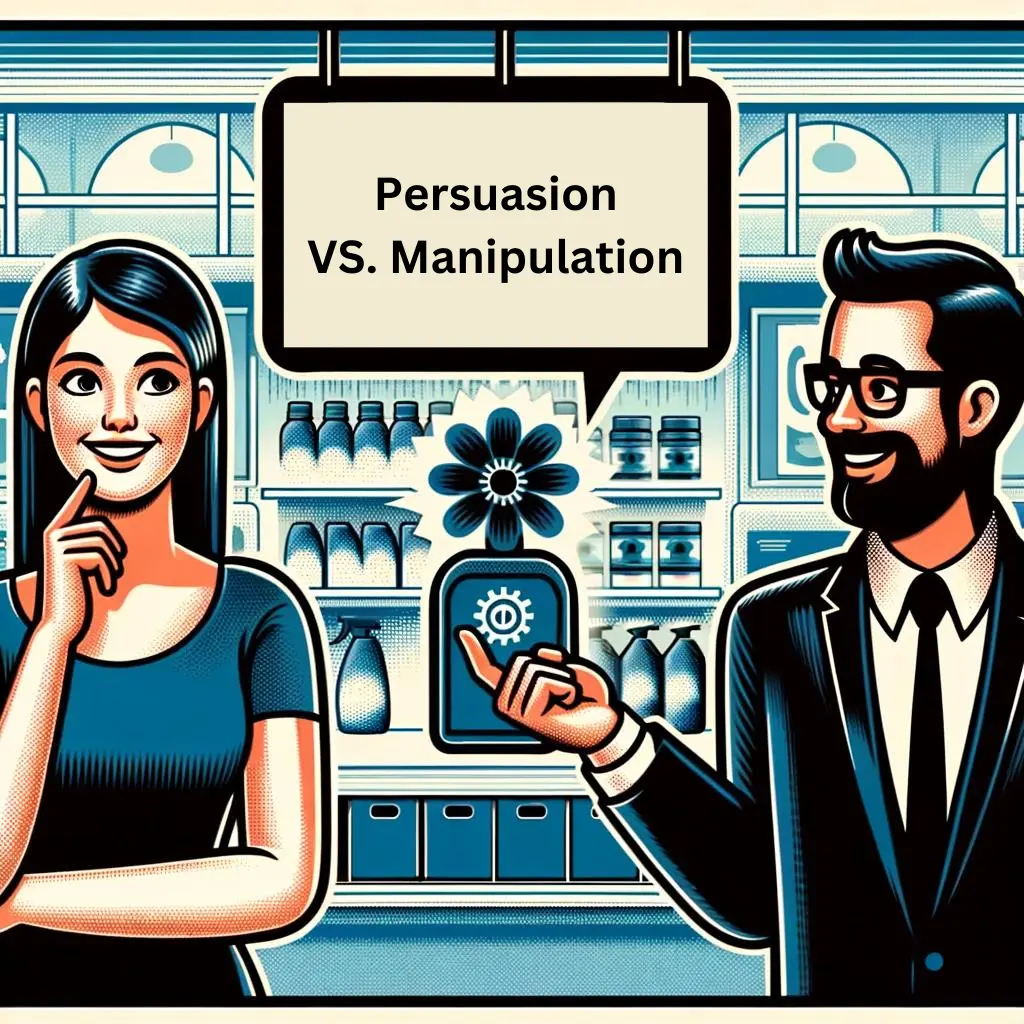- Introduction to Manipulation vs. Persuasion: Understanding the Ethical Lines in Influence
- What is Ethical Persuasion?
- What is Manipulation?
- Navigating the Ethical Line
- Contrast and Compare: Ethical Persuasion vs. Manipulation
- Conclusion: Distinguishing Between Persuasion and Manipulation
- Frequently Asked Questions: Manipulation vs. Ethical Persuasion
- What is the key difference between manipulation and ethical persuasion?
- Can manipulation ever be considered ethical?
- How can one recognize if they are being manipulated?
- What are some common techniques used in manipulation?
- How can one effectively use ethical persuasion in leadership?
- What role does trust play in ethical persuasion?
- Additional Resources
Introduction to Manipulation vs. Persuasion: Understanding the Ethical Lines in Influence
Imagine you’re faced with a decision that could change your life: a new job offer, a major purchase, or even a relationship commitment. Now, imagine that the information you used to make that decision wasn’t entirely truthful—shaded with subtle manipulations rather than clear, honest facts. Every year, millions find themselves in such situations, influenced not by fair persuasion but by manipulative tactics designed to sway. This distinction between manipulation and ethical persuasion isn’t just theoretical; it affects decisions in politics, marketing, and personal relationships every day, impacting trust and outcomes across all levels of society.
In the complex interplay of social interactions, understanding the difference between manipulation and ethical persuasion is crucial for maintaining integrity and respect. This article dives into the nuances that differentiate these two forms of influence, providing insights on how to ethically persuade without crossing into the realm of manipulation.

What is Ethical Persuasion?
Ethical persuasion is about influencing others while respecting their autonomy and maintaining transparency. It aims for mutual benefits, utilizing logical reasoning or emotional appeals that are open and honest. Ethical persuasion considers the well-being of others, ensuring that any influence respects the individual’s ability to make decisions for themselves.
Principles of Ethical Persuasion
- Respect for Autonomy: Ethical persuasion always respects the individual’s freedom to make their own choices, even if those choices differ from the persuader’s preferences.
- Transparency: Ethical persuasion involves clear, honest communication where all relevant information is shared to aid informed decision-making.
- Mutual Benefit: True persuasion seeks outcomes that benefit all involved parties, not just the persuader.

Ethical Persuasion in Leadership: The Principle of Consistency
Ethical persuasion in leadership often leverages the principle of ‘Consistency’ to foster a positive and cooperative environment. Leaders who employ this strategy encourage their team members to make small, voluntary commitments that are aligned with larger organizational goals. This approach not only respects individual autonomy but also builds a culture of trust and accountability. By allowing team members to gradually commit to a vision, leaders ensure that these commitments are genuine and sustainable, enhancing team cohesion and productivity.
What is Manipulation?
Manipulation, in contrast, is often seen as a darker form of influence. It involves using deceptive, coercive, or underhanded tactics to sway others to one’s advantage, often at the expense of their autonomy and well-being. Manipulators exploit emotional, cognitive, or relational vulnerabilities to achieve their goals, leaving the manipulated feeling disempowered or misled.
Characteristics of Manipulation
- Self-Serving Intent: Manipulation is primarily driven by the manipulator’s interests, often disregarding the needs or desires of others.
- Deception and Coercion: Manipulators often use misleading information or emotional exploitation to influence others.
- Undermining Autonomy: Manipulation restricts the individual’s freedom, manipulating their choices through pressure or deceit.

Manipulation in Marketing: The Tactic of Scarcity
In the realm of marketing, the tactic of ‘Scarcity’ is a prevalent example of manipulation. Companies might artificially limit the availability of a product to create a sense of urgency among consumers. Although effective in boosting sales in the short term, this strategy can cross ethical boundaries if it leads to unnecessary panic or misleads consumers about the actual demand or availability of the product. Such manipulative practices can undermine consumer trust and have long-term negative impacts on brand reputation.
Navigating the Ethical Line
The line between persuasion and manipulation can sometimes blur, especially in complex social or professional scenarios where influence plays a significant role. Understanding and respecting this line is crucial for ethical interactions:
- Awareness of Intent: Reflect on the purpose of your influence. Are you aiming to empower the other person to make an informed decision, or are you looking to gain an advantage at their expense?
- Clarity and Honesty: Ensure all communication is transparent and all facts are presented honestly, allowing the other party to make decisions based on accurate information.
- Respecting Boundaries: Recognize and respect the boundaries of others. Influence should not turn into coercion or pressure.
Distinguishing Between Persuasion and Manipulation: The Sales Perspective
The distinction between persuasion and manipulation can often be observed in sales interactions. For instance, a salesperson who emphasizes only the benefits of a product while omitting its potential drawbacks may be veering towards manipulation rather than ethical persuasion. True ethical persuasion involves full transparency, where all relevant information—including any potential negatives—is disclosed. This allows consumers to make fully informed decisions, respecting their autonomy and fostering a relationship based on trust and honesty.

Contrast and Compare: Ethical Persuasion vs. Manipulation
While ethical persuasion and manipulation both aim to influence, they differ significantly in their approach and ethical implications. Ethical persuasion is rooted in respect for the individual’s autonomy, involves transparent communication, and seeks mutual benefits. It encourages informed decision-making based on complete and honest information. In contrast, manipulation often involves deceit, exploits vulnerabilities, and prioritizes the manipulator’s needs over the well-being of others. By comparing these approaches side by side, readers can more easily recognize and differentiate them in real-life situations, enhancing their ability to engage in more ethical and effective communication.

Conclusion: Distinguishing Between Persuasion and Manipulation
Understanding the distinctions between manipulation and ethical persuasion is more than an academic exercise—it’s a practical necessity for fair and respectful human interactions. By committing to the principles of ethical persuasion, individuals and leaders can foster environments of trust and mutual respect, while avoiding the pitfalls of manipulative behaviors. This balance is not only crucial for personal relationships but also in professional settings, where the integrity of influence can define the quality of leadership and collaboration.
Long-Term Effects: Personal and Societal Impacts
Discussing the long-term effects of both manipulation and ethical persuasion can significantly enrich the narrative. Ethical persuasion tends to build lasting relationships based on trust, respect, and mutual understanding, fostering environments where collaboration and personal growth can thrive. These positive interactions contribute to a healthier society where individuals feel valued and empowered. On the other hand, manipulation can lead to short-term gains but often results in long-term damage such as broken trust, resentment, and psychological harm, which can erode personal relationships and degrade the social fabric. By understanding these impacts, individuals and organizations can better appreciate the importance of fostering ethical persuasion and avoiding manipulative behaviors.
In mastering the art of ethical persuasion, we harness the power of influence responsibly, ensuring that our interactions remain respectful and constructive, enhancing both personal and professional growth.

Frequently Asked Questions: Manipulation vs. Ethical Persuasion
What is the key difference between manipulation and ethical persuasion?
The key difference lies in the intent and methods used. Ethical persuasion aims to influence others while respecting their autonomy and encouraging informed decisions based on honesty and mutual benefit. Manipulation, on the other hand, typically involves deceit, coercion, and prioritizes the manipulator’s interests often at the expense of others. Ethical persuasion fosters trust and positive relationships, whereas manipulation can erode trust and lead to negative consequences.
Can manipulation ever be considered ethical?
Manipulation is generally viewed negatively because it often involves deceit and coercion. However, some argue that manipulation can be benign or even beneficial in certain contexts, such as in advertising or parental guidance, where the intention is to encourage positive behavior or decisions. Nonetheless, the ethicality of such manipulation depends heavily on the intent, transparency, and the impact on the autonomy of the individual being influenced.
How can one recognize if they are being manipulated?
Recognizing manipulation involves paying attention to several key indicators: feeling pressured or rushed into making decisions, experiencing guilt or fear as a primary motivator, noticing inconsistencies or blatant deceit in the information provided, or feeling that your autonomy is being restricted. Being aware of these signs can help individuals identify manipulative tactics and protect their own interests and well-being.
What are some common techniques used in manipulation?
Common manipulative techniques include gaslighting, where the manipulator makes someone doubt their own reality or sanity; fearmongering, which uses fear to influence behavior; and exploiting vulnerabilities, where a manipulator uses intimate knowledge of someone’s fears, desires, or weaknesses to influence them. These methods contrast sharply with ethical persuasion, which relies on open, honest communication and respect for the individual’s autonomy.
How can one effectively use ethical persuasion in leadership?
Effective ethical persuasion in leadership involves several key practices:
- Listening and Understanding: Truly understanding the needs, desires, and viewpoints of others before attempting to influence.
- Clear Communication: Providing all relevant information honestly and clearly to ensure that others can make informed decisions.
- Empathy and Respect: Engaging with others in a way that respects their feelings, perspectives, and autonomy, promoting an environment of mutual trust and respect.
What role does trust play in ethical persuasion?
Trust is fundamental to ethical persuasion. It ensures that the persuader respects the values, autonomy, and decisions of those they seek to influence. Trust also enhances the effectiveness of persuasion, as individuals are more likely to be influenced by someone, they trust to be honest and considerate of their best interests. Building and maintaining trust requires consistent honesty, integrity, and consideration for the welfare of others.
These FAQs should serve as a guideline for understanding and navigating the complex dynamics between manipulation and ethical persuasion, aiding in more informed and respectful interpersonal interactions.

Additional Resources
For those interested in exploring the topics of manipulation and ethical persuasion further, here are some resources that provide valuable insights and deeper understanding:
- The Ethical Edge of Persuasion – Psychology Today This article discusses the nuances of ethical persuasion and the importance of maintaining integrity and respect in influencing others. It provides a detailed look at the principles that define ethical persuasion. Read more at Psychology Today
- The Fine Line Between Persuasion and Manipulation: Ethics in Influence – Machiavellian Mastery This resource explores the balance between Stoic virtue and Machiavellian strategy in persuasion, and how ethical considerations play a crucial role in influence tactics. Explore further on Machiavellian Mastery
- Persuasion vs. Manipulation: Understanding the Fine Line – The Power Moves A deep dive into the subtle differences and the often-blurred lines between persuasion and manipulation, including practical examples and case studies. Learn more at The Power Moves
- Persuasion vs. Manipulation Debate: Is There a Difference? – Academic Help This article provides a clear distinction between persuasion and manipulation, emphasizing the importance of intent, transparency, and respect for autonomy in ethical persuasion. Visit Academic Help for more information
- Persuasion vs. Manipulation — What’s the Difference? – Ask Difference An overview of the definitions, differences, and ethical considerations of persuasion and manipulation, offering insights into their impact on social interactions. Check out Ask Difference















